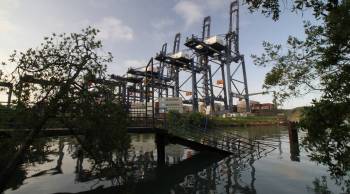You can bury something that’s toxic, but that doesn’t mean it won’t get you eventually. As I thought about the toxic bank assets, something else came to mind, something with a personal connection. It’s one of the worst environmental tragedies the country has ever seen.
I’ll give an abbreviated version of the story. Love Canal was named for William Love, an 1890’s developer who envisioned a beautiful community built on a canal in Niagara Falls, New York. Love started digging his trench but ran out of money, and the project was abandoned. What was left was basically a big ditch.
In the 1920’s, that ditch became a dumping site for the city of Niagara Falls and was later purchased by Hooker Chemical company. Hooker used it as a dump site as well.
In the early 50’s, my father went to elementary school right next to this dump site. He remembers being out on the playground with his friends, throwing rocks at piles of graphite to watch them go “poof.” There were always “barrels of things” lying around. He didn’t know what they were, but we do now — 21,000 tons of chemical waste.
About the time my dad switched schools, Hooker closed the site and covered it with dirt. Niagara Falls was growing and needed more land, so the local school board tried to buy part of the area that hadn’t been used for dumping yet. According to Wikipedia, Hooker warned that no one should buy the land: The area should be sealed off “so as to prevent the possibility of persons or animals coming in contact with the dumped materials.”
Hooker begrudgingly agreed to sell anyway, in exchange for a release from legal liability. The school board paid a dollar for the land, and what did it do? It built another school. A neighborhood popped up around it.
Fast forward to 1978. Here was the New York Times front page on August, 1, 1978:
NIAGARA FALLS, N.Y.–Twenty five years after the Hooker Chemical Company stopped using the Love Canal here as an industrial dump, 82 different compounds, 11 of them suspected carcinogens, have been percolating upward through the soil, their drum containers rotting and leaching their contents into the backyards and basements of 100 homes and a public school built on the banks of the canal.
The regional head of the EPA, Eckardt C. Beck, said this:
I visited the canal area at that time. Corroding waste-disposal drums could be seen breaking up through the grounds of backyards. Trees and gardens were turning black and dying. One entire swimming pool had been had been popped up from its foundation, afloat now on a small sea of chemicals. Puddles of noxious substances were pointed out to me by the residents. Some of these puddles were in their yards, some were in their basements, others yet were on the school grounds. Everywhere the air had a faint, choking smell. Children returned from play with burns on their hands and faces.
The neighborhood was stricken with cancers, birth defects, nervous disorders. The area was essentially evacuated (some people stayed), but the legal battles dragged on for years.
Sure, Hooker Chemical dumped the stuff, but the government — local, state and federal — just left it there and did nothing about it. In fact, they allowed a school and a neighborhood to be built right on top of it!
We have a long tradition in this country of doing this — burying things and pretending they won’t be a problem. And we seem to be doing it again with these toxic assets (bundles of potentially bad residential and commercial real estate loans). The Bank for International Settlements issued a report yesterday saying this:
Taxpayers around the world still face potentially large losses because governments have failed to act quickly enough to remove toxic assets from the balance sheets of key banks.
The assets are still there, buried beneath the surface. And like Hooker Chemical, the banks don’t want to sell them because they’re dangerous and they’re worth about as much as that Love Canal land. Here’s what Amy Scott reported on Marketplace yesterday:
Problem is, those banks don’t want to sell. I asked Josh Rosner with advisory firm Graham-Fischer why. He points at my wrist.
JOSH ROSNER: You’ve got a watch. And when you bought the watch your watch was a $5,000 watch.
SCOTT: I wish.
But anyway, let’s say my watch is now worth half what I paid.
ROSNER: So if you were forced to sell it, you’d realize a $2,500 loss.
SCOTT: But if I just keep it on my wrist…
ROSNER: If you keep it on your wrist then there’s no loss to be had. So that’s exactly the situation.
More from analyst Paul Miller:
PAUL MILLER: The bottom line is that we have not addressed the toxic assets on these balance sheets, and until we address them, we’re going to still struggle in this environment, and just jump from crisis to crisis.
The banks are hoping the assets will bloom into pretty flowers instead of continuing to drip sickening chemicals onto their books.
Love Canal helped prompt the Superfund legislation, and one of the things that was said about it was that Love Canal became “the symbol for what happens when hazardous industrial products are not confined to the workplace but ‘hit people where they live’ in unestimable amounts.”
So are we going to wait for these bank assets to hit people where they live in unestimable amounts?
There’s a lot happening in the world. Through it all, Marketplace is here for you.
You rely on Marketplace to break down the world’s events and tell you how it affects you in a fact-based, approachable way. We rely on your financial support to keep making that possible.
Your donation today powers the independent journalism that you rely on. For just $5/month, you can help sustain Marketplace so we can keep reporting on the things that matter to you.


















